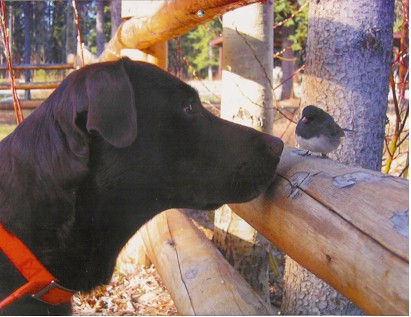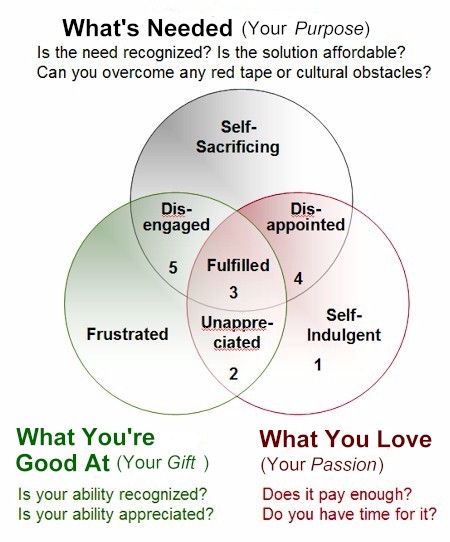 Readers of How to Save the World know that I’m a big fan of visualizations as a way of adding meaning and value to information, and as a vehicle for reintermediation and the re-emergence of a critical business and social role for information professionals as specialists who do their craft better than any generalist can hope to do. Likewise, I’m a fan of Rob Cross’ approach to social network mapping — focusing on the assessed quality of relationships rather than just their quantity or frequency. And I think the most important value of social network maps lies in self-assessment — what a map of others’ perceptions of your social networks tells you about yourself and the nature and quality of your own relationships.. So I was intrigued to discover that one of the most popular social network maps on the web (reproduced above) looks utterly different from most of the maps I’ve seen before, which tend to be hub-and-spoke type drawings with a few overly-busy people with too many links and a few loners with too few. This particular map was developed by a professor in the US based on a survey of every student in a typical American high school, and depicts all their ‘sexual or romantic’ relationships over the past half-year. Far from hub (the sexual athletes) and spoke (their conquests) with disconnected outliers (the school nerds et al), the picture is one of remarkable fidelity and many tiny, almost nuclear clusters. Sixty-three couples (126 students) had sex only with each other, and 63 other students were involved in closed triads — one or two partners with no overlap with anyone else in the school. Another 94 students were involved in other small clusters, and of them 79 had only one sexual partner in that cluster. Then there was a long, thin network connecting 288 students with up to 37 degrees of separation, the vast majority of whom also had only sexual partner. Most of the students in this giant cluster would have been flabbergasted to realize they were part of such a network, and (unless shown otherwise) would justifiably perceive their relationship map no differently from those in the nuclear clusters with two or three participants. What does this mean? The link above is illuminating, but it is quite narrowly focused on preventing STDs (i.e. forget looking for hubs to teach/treat; a much broader approach is needed). I think this map raises more questions than it answers, and also has some important implications for the value of network maps in the first place:
As intriguing as the map is, to me it poses the same huge risk as any other analysis of complex information: the risk that people will draw simple conclusions and propose complicated ‘solutions’ by misinterpreting or oversimplifying or placing far too much importance on this tiny, flawed, partial picture of a profoundly complex phenomenon, in this case the phenomenon of human networks and relationships. It reminds me a bit of the old John Saxe poem about the six blind men trying to describe an elephant. We cannot hope to fathom human relationships, so we try to simplify them down in some way that will allow us to see the patterns and therefore come up with a course of action that, if imperfect, is better than doing nothing. The problem is that it isn’t necessarily better than doing nothing. AsJames Cascio said (perhaps quoting someone else — thanks to Martin Cleaver for the citation) the map is not the terrain. Category: Complexity and Discovery
|
Navigation
Collapsniks
Albert Bates (US)
Andrew Nikiforuk (CA)
Brutus (US)
Carolyn Baker (US)*
Catherine Ingram (US)
Chris Hedges (US)
Dahr Jamail (US)
Dean Spillane-Walker (US)*
Derrick Jensen (US)
Dougald & Paul (IE/SE)*
Erik Michaels (US)
Gail Tverberg (US)
Guy McPherson (US)
Honest Sorcerer
Janaia & Robin (US)*
Jem Bendell (UK)
Mari Werner
Michael Dowd (US)*
Nate Hagens (US)
Paul Heft (US)*
Post Carbon Inst. (US)
Resilience (US)
Richard Heinberg (US)
Robert Jensen (US)
Roy Scranton (US)
Sam Mitchell (US)
Tim Morgan (UK)
Tim Watkins (UK)
Umair Haque (UK)
William Rees (CA)
XrayMike (AU)
Radical Non-Duality
Tony Parsons
Jim Newman
Tim Cliss
Andreas Müller
Kenneth Madden
Emerson Lim
Nancy Neithercut
Rosemarijn Roes
Frank McCaughey
Clare Cherikoff
Ere Parek, Izzy Cloke, Zabi AmaniEssential Reading
Archive by Category
My Bio, Contact Info, Signature Posts
About the Author (2023)
My Circles
E-mail me
--- My Best 200 Posts, 2003-22 by category, from newest to oldest ---
Collapse Watch:
Hope — On the Balance of Probabilities
The Caste War for the Dregs
Recuperation, Accommodation, Resilience
How Do We Teach the Critical Skills
Collapse Not Apocalypse
Effective Activism
'Making Sense of the World' Reading List
Notes From the Rising Dark
What is Exponential Decay
Collapse: Slowly Then Suddenly
Slouching Towards Bethlehem
Making Sense of Who We Are
What Would Net-Zero Emissions Look Like?
Post Collapse with Michael Dowd (video)
Why Economic Collapse Will Precede Climate Collapse
Being Adaptable: A Reminder List
A Culture of Fear
What Will It Take?
A Future Without Us
Dean Walker Interview (video)
The Mushroom at the End of the World
What Would It Take To Live Sustainably?
The New Political Map (Poster)
Beyond Belief
Complexity and Collapse
Requiem for a Species
Civilization Disease
What a Desolated Earth Looks Like
If We Had a Better Story...
Giving Up on Environmentalism
The Hard Part is Finding People Who Care
Going Vegan
The Dark & Gathering Sameness of the World
The End of Philosophy
A Short History of Progress
The Boiling Frog
Our Culture / Ourselves:
A CoVid-19 Recap
What It Means to be Human
A Culture Built on Wrong Models
Understanding Conservatives
Our Unique Capacity for Hatred
Not Meant to Govern Each Other
The Humanist Trap
Credulous
Amazing What People Get Used To
My Reluctant Misanthropy
The Dawn of Everything
Species Shame
Why Misinformation Doesn't Work
The Lab-Leak Hypothesis
The Right to Die
CoVid-19: Go for Zero
Pollard's Laws
On Caste
The Process of Self-Organization
The Tragic Spread of Misinformation
A Better Way to Work
The Needs of the Moment
Ask Yourself This
What to Believe Now?
Rogue Primate
Conversation & Silence
The Language of Our Eyes
True Story
May I Ask a Question?
Cultural Acedia: When We Can No Longer Care
Useless Advice
Several Short Sentences About Learning
Why I Don't Want to Hear Your Story
A Harvest of Myths
The Qualities of a Great Story
The Trouble With Stories
A Model of Identity & Community
Not Ready to Do What's Needed
A Culture of Dependence
So What's Next
Ten Things to Do When You're Feeling Hopeless
No Use to the World Broken
Living in Another World
Does Language Restrict What We Can Think?
The Value of Conversation Manifesto Nobody Knows Anything
If I Only Had 37 Days
The Only Life We Know
A Long Way Down
No Noble Savages
Figments of Reality
Too Far Ahead
Learning From Nature
The Rogue Animal
How the World Really Works:
Making Sense of Scents
An Age of Wonder
The Truth About Ukraine
Navigating Complexity
The Supply Chain Problem
The Promise of Dialogue
Too Dumb to Take Care of Ourselves
Extinction Capitalism
Homeless
Republicans Slide Into Fascism
All the Things I Was Wrong About
Several Short Sentences About Sharks
How Change Happens
What's the Best Possible Outcome?
The Perpetual Growth Machine
We Make Zero
How Long We've Been Around (graphic)
If You Wanted to Sabotage the Elections
Collective Intelligence & Complexity
Ten Things I Wish I'd Learned Earlier
The Problem With Systems
Against Hope (Video)
The Admission of Necessary Ignorance
Several Short Sentences About Jellyfish
Loren Eiseley, in Verse
A Synopsis of 'Finding the Sweet Spot'
Learning from Indigenous Cultures
The Gift Economy
The Job of the Media
The Wal-Mart Dilemma
The Illusion of the Separate Self, and Free Will:
No Free Will, No Freedom
The Other Side of 'No Me'
This Body Takes Me For a Walk
The Only One Who Really Knew Me
No Free Will — Fightin' Words
The Paradox of the Self
A Radical Non-Duality FAQ
What We Think We Know
Bark Bark Bark Bark Bark Bark Bark
Healing From Ourselves
The Entanglement Hypothesis
Nothing Needs to Happen
Nothing to Say About This
What I Wanted to Believe
A Continuous Reassemblage of Meaning
No Choice But to Misbehave
What's Apparently Happening
A Different Kind of Animal
Happy Now?
This Creature
Did Early Humans Have Selves?
Nothing On Offer Here
Even Simpler and More Hopeless Than That
Glimpses
How Our Bodies Sense the World
Fragments
What Happens in Vagus
We Have No Choice
Never Comfortable in the Skin of Self
Letting Go of the Story of Me
All There Is, Is This
A Theory of No Mind
Creative Works:
Mindful Wanderings (Reflections) (Archive)
A Prayer to No One
Frogs' Hollow (Short Story)
We Do What We Do (Poem)
Negative Assertions (Poem)
Reminder (Short Story)
A Canadian Sorry (Satire)
Under No Illusions (Short Story)
The Ever-Stranger (Poem)
The Fortune Teller (Short Story)
Non-Duality Dude (Play)
Your Self: An Owner's Manual (Satire)
All the Things I Thought I Knew (Short Story)
On the Shoulders of Giants (Short Story)
Improv (Poem)
Calling the Cage Freedom (Short Story)
Rune (Poem)
Only This (Poem)
The Other Extinction (Short Story)
Invisible (Poem)
Disruption (Short Story)
A Thought-Less Experiment (Poem)
Speaking Grosbeak (Short Story)
The Only Way There (Short Story)
The Wild Man (Short Story)
Flywheel (Short Story)
The Opposite of Presence (Satire)
How to Make Love Last (Poem)
The Horses' Bodies (Poem)
Enough (Lament)
Distracted (Short Story)
Worse, Still (Poem)
Conjurer (Satire)
A Conversation (Short Story)
Farewell to Albion (Poem)
My Other Sites



 Until about 15 years ago, the way people consulted with each other was through face-to-face meetings and visits (often impromptu, spur-of-the-moment occurrences). When that was impossible, people conversed by telephone, in real dialogue. Likewise, until about 15 years ago, the way people did research was to go and visit (or, if that was not possible, telephone) the library and talk to the information professional (IP) about what they needed, and then leave it to the IP to get it.
Until about 15 years ago, the way people consulted with each other was through face-to-face meetings and visits (often impromptu, spur-of-the-moment occurrences). When that was impossible, people conversed by telephone, in real dialogue. Likewise, until about 15 years ago, the way people did research was to go and visit (or, if that was not possible, telephone) the library and talk to the information professional (IP) about what they needed, and then leave it to the IP to get it.









